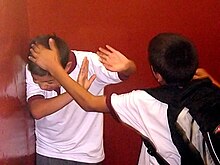What is Bullying?
Bullying is
unwanted, aggressive behavior among school aged children that involves a real
or perceived power imbalance. The behavior is repeated, or has the potential to
be repeated, over time. Both kids who are bullied and who bully others may have serious, lasting problems.
Types
of Bullying
Physical
Bullying
This is any unwanted physical
contact between the bully and the victim. This type of bullying is the most
easily identifiable form of bullying. Examples include:
Emotional
Emotional bullying is any form of
bullying that causes damage to a victim’s psyche and/or emotional well-being.
Examples include:
·
keeping certain people out of a "group"
·
getting certain people to "gang up" on others (could also be
considered physical bullying)
·
making fun of certain people
·
provocation
·
pretending the victim is non-existent
·
saying hurtful sentences (also a form of verbal bullying)
·
belittling
Verbal
Verbal bullying is any slanderous
statements or accusations that cause the victim undue emotional distress.
Examples include:
·
directing foul language (profanity) at the target
·
using derogatory terms or deriding the person's name
·
commenting negatively on someone's looks, clothes, body etc. – personal
abuse
·
tormenting
·
mocking
·
teasing
·
belittling
According to
the website Stop Cyberbullying, "Cyberbullying is when a child, preteen or
teen is tormented, threatened, harassed, humiliated, embarrassed or otherwise
targeted by another child, preteen or teen using the Internet, interactive and
digital technologies or mobile phones." This
form of bullying can easily go undetected because of lack of
parental/authoritative supervision. Because bullies can pose as someone else,
it is the most anonymous form of bullying. Cyber-bullying includes, but is not
limited to, abuse using e-mail, blogs, instant messaging, text messaging or
websites. Many who are bullied in school are likely to be bullied over the
Internet, and vice versa.
Sexual bullying
Sexual bullying is "any bullying behavior, whether
physical or non-physical, that is based on a person’s sexuality or gender. It
is when sexuality or gender is used as a weapon by boys or girls towards other
boys or girls—although it is more commonly directed at girls. It can be carried
out to a person’s face, behind their back or through the
use of technology.
Pack bullying
Pack
bullying is bullying undertaken by a group. The 2009 Wesley Report on bullying
prepared by an Australia-based group, found that pack bullying was more
prominent in high schools and characteristically lasted longer than bullying
undertaken by individuals. Pack bullying may be physical bullying or emotional
bullying and may be perpetrated in person or in cyberspace. It can take place
in schoolyards, school hallways, sports fields and gymnasiums, classrooms and
on the school bus.
Bystanders to Bullying
According to Department of Education and Training of Western Australia, bullying also involves the concept of “bystanders”. A bystander may be someone who sees bullying or knows about it, but he or she is not usually directly involved. Everyone at the school can have a role in supporting those who are being bullied. All members of the whole school community need to be aware of their role in supporting those who are being bullied and their responsibility to discourage bullying behaviours when they observe them. Any member of the school community can be a bystander and can act successfully to prevent or stop bullying. Bystanders are encouraged to report to someone who can help, such as a member of the school staff.
Assignment
Create an Anti-bullying brochure to highlight the types, causes, effects/consequences and prevention measures.


No comments:
Post a Comment